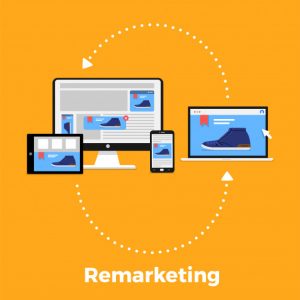Case Study: $17,200 a Month Retargeting to Different Niches

Retargeting marketing reminds your website visitors of your products and services after they leave your website without buying.
Retargeting Case Study
If you have a good product that can be repurposed or retargeted to different niches, then you can do this.
You want to have a ‘universal’ product that appeals to a broad spectrum of users.
For example, it might be a plugin for business websites, a course on marketing, a product on how to make business-to-customer videos, a grant writing course, and so forth.
In this case study, I have a friend who has a course on building websites for people who don’t have a clue how to do it.
Now, I know your first thought is probably the same one I had: Why would anyone PAY for a course on how to build websites, when there is plenty of free information out there that teaches you how to do it?
Maybe people are lazy and don’t want to do the research themselves.
Or they don’t know the information is available for free.
Or more likely, they don’t know WHICH information to follow.
They can look at 5 different search results and get 5 different answers.
Which one should they use?
What’s the best one?
How do they avoid mistakes?
And so forth.
If you can simplify and clarify things for them, they’ll gladly pay you.

Plus, while most people have a good idea of how to go about building a website, they still feel better if an ‘expert’ shows them step by step how to do it.
The added lesson here is this: If you’re afraid to create or launch a product because the information is already available online for free, stop worrying.
Most information products contain a ton of info that’s readily available for free.
It’s just the nature of the business.
Back to the case study: My friend made a course on how to build a business-to-customer type of website.
He used some PLR and added his own stuff into the mix as well, and it’s a good course that delivers on its promises.
But here’s the twist: He markets this course to all different niches.
For example, he’s sold this course to dog groomers, accountants, lawyers, plumbers, cleaning services, restaurants, and more.
He markets the course online and offline, by advertising to each niche individually.
Naturally, he targets small business owners who aren’t tech-savvy and just want to develop their online presence themselves.
And here’s a really interesting tidbit – he charges whatever his market will bear.
A dentist or lawyer can afford to pay more than a yard maintenance person (someone who cuts lawns.)
His method to determine the correct price point for each niche is to continue to raise prices until his return on investment decreases.
Notice he’s tracking ROI and not conversion rates.
A lower conversion rate at a higher price point can mean more profits than a higher conversion rate at a lower price point.
And while you might think he tailors the course to each niche, between you and me, he doesn’t bother.
It’s the exact same course.
The only thing he changes is the advertising that he uses.

For example, he might advertise, “Plumbers, create your own website using free online tools in just 24 hours.”
And then he’ll simply replace the word, “Plumbers” with whatever profession he’s targeting.
His plan is to target a hundred different professions and businesses.
And while each buyer will think the product is specifically tailored to their niche, it isn’t.
Is this ethical?
Since he never promises that there is any information that is specifically for one profession or another, I think it’s fine.
Of course, you could make alterations to your own course to make it look like it’s more customized.
And your course doesn’t have to be on building websites – it could be on anything that businesses need, like getting new customers or automating some aspect of their business, like list building.
One more thing – he makes a second stream of income by selling a done-for-you service, too.
For those who buy his course and don’t want to put in the work of building their own website, he has his team of outsourcers build the site for them.
He discounts the cost of the website by however much they paid for the course, so the course is then ‘free.’
He’s now closing in on $20,000 a month doing this, and I’d estimate he spends about 10 hours a week on the business.
Not bad.
Where the Money is Hidden

They used to say, “The money is on the list.”
And that’s still true.
But perhaps the REAL money these days is hidden someplace else.
Read more: Hidden profits
Somewhere you might not be looking…
Jeff Walker, in a recent video, confessed that he is a “numbers geek.”
Meaning he likes to pour over the numbers in his business to find out what’s working.
And it tends to be the most important time he spends on his business, too.
Here is a stat he says will change your business: “It is 15 times easier to make the second sale to your clients than it is to make the first sale.”
15 times easier!
But most online marketers aren’t looking to make the second sale because they’re too focused on making the first sale.
If your only focus is on making one sale and then being done with a customer, then odds are you will never have a truly robust business.
There is simply too much competition out there now, and it’s getting more and more expensive to get new customers, too.
When you add in a backend product, you can double your sales.
DOUBLE your sales!
People want mastery, convenience, speed, or a closer connection to you.
And that’s what you’ll deliver on your backend.
How much should you charge?
Jeff says that 20% of your buyers will pay 5 times the initial product cost for that backend product.
If your initial offer is $100, then charge $500 for the backend product.
If the front-end product is $400, then charge $2000 for the back-end product, and so forth.
Your backend isn’t about delivering 5 times the stuff, but rather 5 times the depth.
Maybe you offer coaching – there is no ‘stuff,’ per se, except for your time.
Or maybe you offer a done for your solution.
For example, your initial product teaches how to do something, and you charge $100 for it.
But if they would like you to do it for them (or rather, your outsourcers) then you charge 5 times as much and your customer is thrilled they don’t have to suffer through all the steps and work involved in getting that result.
Bottom line: If you don’t have a backend built into your business, get one.
Or if you’re like Jeff Walker and you offer EVERYTHING a person needs to get the solution they want in the first product, then offer another, complementary product that covers the next step of whatever it is they’re trying to accomplish.
And if you’re truly stuck for what to offer, then make it simple: Offer one-on-one coaching to help them do what’s in your initial product.
For example, for $200 you teach them how to set up a non-profit status for their organization.
But for $1000 you personally coach them over the phone or Skype on each step of the process.
Basically, you’re holding their hand and giving them the encouragement they need to see the process through, which might take 5 to 10 thirty-minute phone calls.
Do the math and you’re earning $200 an hour, or more.
One more note from Jeff: Having a backend changes your math.
Because you have (typically) doubled how much revenue you take in, you’re doubling how much each customer is worth.
This allows you to spend more on advertising while continuing to bank more profit, which leads to even more sales and yes, more profit.
The value of a backend cannot be overstated.
And when the day comes to sell your business – if and when you get tired of it – then your business will be worth twice (or more) what it would have been worth if you did not have that backend.
If you have a business already, add a backend.
If you’re just starting a business, have an idea upfront of what your backend will be.
It will give you a more robust, more secure business and allow you to retire that much sooner.
Is Your Product, Service or Business Memorable?

It’s not enough to have a great product or service – you need that product or service to be memorable and stand out in the prospect’s mind when it comes time to buy.
If you’re at a marketing conference, meeting new potential joint venture partners, how do you stand apart from the rest of the crowd, so that they’ll remember you after they get home?
And for that matter, what makes an idea, product, event or person memorable?
For something to be truly memorable, it needs two things:
It needs to be intellectually confounding or challenging in a way that catches your prospect’s attention.
And it has to target emotions on a very extreme level.
Happy, surprised, sad… it’s got to be some level of emotion that is triggered in your prospect.
Both of these must happen at the same time, and the higher the intellectual challenge AND the higher the emotion, the more memorable your product becomes.
Do you remember losing your virginity?
Why is it that this event is so memorable?
First, you received new intellectual content – your life was never going to be the same, you experienced something brand new to you, things were going to change… and you felt a lot of emotions, too.
It was a unique concept for you.
Do you remember 9-11?
It was a unique concept, in that it had never been done before.
Someone took a plane and flew it into the side of a building in downtown Manhattan.
It was so astounding and jarring intellectually, we even questioned if what we were seeing was real.
And then came the extremely high emotions of anger, sadness, fear, depression, and so on.
Let’s contrast this with something that isn’t memorable.
You go online and you read an article that is REALLY interesting.
You’re engrossed in it because it’s so fascinating.
But there is no emotion involved, and so what happens?
In a few days, you forget all about it.
It’s like it never happened, you never read the article and you never got the information because it is gone from your memory.
It didn’t stick.
Or you see a commercial on television asking for money for starving children.
It makes you so sad and hurt, you want to cry.
But there is no intellectual stimulation, and an hour later you’ve forgotten all about it.

When you can get something to register as highly as possible on both scales – intellectual and emotional – at the same time, it will make the difference between whether something is memorable or not memorable.
Let’s use movies as examples of what makes something memorable.
In the 70’s we had Jaws, a shark that hunts people.
Most of us like the water and we like to swim.
The thought of a shark hunting us in the water was a new idea for most of us, and we never looked at water the same way again.
And then there is the emotion, the high stress, high anxiety, suspense, and fear throughout the movie, along with the triumph and relief of the shark being killed at the end of the movie.
If you saw Jaws in a movie theater, odds are you never forgot it, even though that was over 40 years ago.
In the ’80s the highest-grossing film was E.T.
There are aliens that come to earth (a new intellectual concept for most people at the time) and there is one in the shed, but he’s quite nice.
We start out feeling fear and stress and wind up getting emotionally attached to this little guy and rooting for him to be able to go back home.
It’s a new idea coupled with strong emotions, and we never forget the movie.
In the 90’s we had Titanic – a movie filled with love, stress, and the intellectual challenge that the hero and heroine would not wind up together (unlike nearly all other love stories.)
If you look at singers, in the 70’s we had Elton John, an openly gay man whose music was embraced by nearly everyone (unheard of at the time.) in the 80’s we had Prince, who dressed strangely, wore tons of makeup and married beautiful women.
In the 90’s we had Madonna, who evoked a variety of strong emotions and continually startled us with her latest incarnation.
And then in the 2000s, we had Eminem; a white rapper named after a candy – who could forget that?
But what about products and companies?
Look at Tom’s Shoes, the company that pledged to give a pair of shoes to an underprivileged person for every pair of shoes sold.
They got so much free publicity, they never needed to advertise.
It was a brand-new idea.
And coupled with the emotion of feeling good because a child in a third world country was wearing shoes because YOU bought shoes for yourself was a total winning combination.
How do we use this information to make our products memorable?
I decided to take three generic products that might be promoted by any online marketer – weight loss, make money online, and dating – and come up with ideas on how to make them memorable.
Mind you, this is just the result of a few minutes of brainstorming.
You’ll want to do your own brainstorming when it comes to your products, but one thing is for sure: If you can build memorability into your product as you’re creating it, rather than try to add it later, you’ll be far ahead of the game.
Here’s what I came up with, allocating just 5 minutes to each general product:
Weight loss
Emotions: Painting a picture of the prospect at the end of their shortened life and all the things they missed out on because they were too out of shape and too embarrassed to take part.
The emotion of never having seen their grandchildren because they died too young (or great-grandchildren).
Being forgotten, or worse yet, being remembered as being HUGE and never leaving the recliner.
Positive emotions – losing weight and being hailed as a conquering hero and inspiration for others.
Living their very best life ever because they were fit and trim and able to do all the things on their bucket list and more. (Weight loss is a great one for evoking emotions.)
Intellectually confounding – this is where you want to be contrary.
If every other weight loss guru says to exercise like crazy, you say the opposite.
If they say to starve or eat a restrictive diet, you say the opposite.
Okay, these ideas probably worked 20 years ago, but nowadays I’m not sure it’s enough.
Turning it up a notch…
How about if you could use psychology to flip a switch in their brain that MADE them CRAVE healthy food and exercise?
Yes! If they could bypass the feeling of deprivation of their favorite foods and the feelings of hating exercise, and suddenly be REPULSED by chocolate cake and in LOVE with broccoli and moving their body… now I think you’ve got something!
Make money online
Emotions – of course, you can paint pictures of all the cars and houses and vacations a person can have… yawn.
Everybody does that, so forget about it.
But what if you paint a picture of them being HEROES using 25% of the millions they make to do something freakin’ AWESOME for others or for a cause?
Now you’re taking the selfishness out of making money and adding in the secret sauce of feeling amazing and powerful because now they can help others and be treated like a hero for it.
Intellectually confounding – I’d go with opposites here, too.
It takes money to make money? No!
Your home is an asset? No!
Saving is the way to get rich? No!
Investing in stocks and mutual funds and diversifying is smart? No!
Tear down all the usual advice that people get, because frankly, it’s all outdated anyway.
Let them know that the people who are REALLY rich don’t do most of the things that they tell the middle class to do, and you’re going to show them what they really do instead.
Be contrary and back it with facts.
Dating

Emotions – Do you want to die alone? 99% of people say they want to have a significant other to be their mate for life, so hitting on the emotions that come when you think about ALWAYS being alone is pretty powerful.
Contrast those emotions with what it’s like to FALL IN LOVE, and now you’ve got ugly and magnificent.
Paint word pictures and use photos, too, to depict the sharp contrast of these two.
Or use a real-life love story of two famous people, and have your prospect imagine they get to experience something just as magical.
Intellectually confounding – What if a change in mindset made all the difference?
No, they don’t need lots of money, a cool car, snazzy clothes, and so forth.
They simply need to change their mindset so that the way they are RIGHT NOW will attract dates.
Again, it’s flipping a switch in the brain – maybe I’m getting redundant here, but when everyone else is telling them to be different, change the way they look, act differently and so forth, and you’re just saying no, all you need to do is change how you THINK… that seems pretty intellectually confounding to me and I want to know more.
Okay, all of that was based on just a few minutes of brainstorming.
Frankly, I think all three could use improvement, but I’ll leave that up to you.
This exercise was to get you moving in the right direction, and now the rest is up to you.
Be memorable.
Make your products memorable.
Stand apart from the crowd and create your own path and even your own niche.
After all, if you’re the only one in the niche you’ve created, you will not only be memorable, but you will have zero competition, too.
Goal Setting that Actually WORKS

By now I’m sure you’ve learned in life that having a goal isn’t enough.
You set a goal, you get all excited, you feel like you’ve already accomplished something, and a week, a month, or a year later, you are no closer to the goal than you were before.
What happened?
First, the setting of the goal gave you immediate satisfaction, so that you didn’t feel you needed to do any more at that point.
Sure, you’d have to work on your goal later, but for the moment, you felt good.
And that inertia of the false feeling of already having accomplished something kept you from moving forward.
Second, if and when you did come back to work on the goal, you realized it wasn’t just a goal.
It was a fat, hairy GOAL with teeth!
It was big and scary and overwhelming and hey, couldn’t you get started on it tomorrow?
But of course!
And so, you very likely didn’t even begin.
If you did get started (good for you, because 2 out of 3 people never even get that far) then you soon felt so overwhelmed, you set it aside for later.
And that ‘later’ never came.
But… if you have MILESTONES to achieving your goal, then you can – wait for it – ACHIEVE YOUR GOAL.
Think of crossing a wide stream of rapidly moving water.
If you try to leap across the stream in one bold move, you’re going to land in the water and get swept downstream.
But if you place several large boulders across the stream, and if you move from one boulder to the next, then you can get across.
Milestones work the same way.
You set several milestones between where you are now and the result you seek.
As you achieve each milestone, you get a sense of accomplishment.
Yes, your goal might seem too big and too grand to achieve.
But you can get to the first milestone, right?
And each milestone has a series of action steps that need to be taken to reach that milestone.
You perform the actions to achieve the milestone.
You achieve several milestones to get to the goal.
And then you’ve done it!
There is nothing new or novel about this approach.
Yet, 9 times out of 10 goals never get achieved because the person setting the goal never broke it down into smaller, manageable steps.
Because most people never map out the specific actions essential to their goals and never schedule these actions, they just turn in circles.
A sense of overwhelm overtakes them because they’re seeing a huge mound of things to do in their mind, but they’ve never gotten specific and organized about how to do those things.
Unless you can see the goal, the milestones, and the actions right in front of you, you’re going to waste a great deal of time and mental energy trying to figure out what to do next.
You’ll do things out of order, you’ll lose your sense of accomplishment, and you’ll get discouraged and quit.
One of the great secrets to getting where you want to go is seeing everything visually in front of you, much like seeing the map on how to get to your destination.
Once you’ve got your goal, you pick out the milestones to be achieved on the way to that goal, and then you write out the actions for each.
As long as you’ve got a specific list of actions to take, you’ve got it made.
Now you can move into action quickly.
If you don’t have a specific list of actions to take, then things are ambiguous – something with which you’re no doubt highly familiar. We think we’re comfortable with ambiguity because it allows us to stay in our comfort zone and not stretch ourselves.
But the funny thing is that there is nothing comfortable about the comfort zone.
It keeps you turning in circles instead of moving ahead.
And it keeps you in a constant state of overwhelm, instead of feeling good about yourself and what you’re accomplishing.
Let’s talk about motivation:
“But what if I have a goal, and I have my milestones, and I have my list of actions for each milestone, but I’m still not motivated?
Then you are experiencing some inner resistance that is stopping you from moving forward.
This inner resistance, whatever it might be, is not going to budge if you try to strong-arm it.
You can’t just fight your way through it using willpower.
Instead, you’ve got to examine your payoff – what the goal is going to do for you or give you when you achieve it – and ask yourself the following questions:
Is the payoff big enough to excite you?

If not, then you don’t have the right goal.
You need a bigger goal.
Your goal should be large, not ‘reasonable.’
It should be exciting.
It should be BIG with a BIG payoff that makes you excited and happy just thinking about it.
If the payoff is big enough to excite you, then ask yourself…
Have you kept the payoff front and center in your mind?
If not, then you know what you need to do – night and day, you need to visualize achieving that goal.
The payoff is the vision embedded in your subconscious that effortlessly sets you on fire with your goal.
Your goal should be something you can’t get out of your mind, something that pulls you along – not something you have to push yourself to accomplish.
Get serious about keeping the vision of the payoff in your mind at all times, because this is the ONE thing that will get you going and KEEP you going.
No one – not the best motivational speaker in the world sitting on your shoulder – can keep the vision of the payoff alive for you.
You must continually stoke that fire and keep that vision front and center in your mind.
How do you do that?
It’s going to depend on your goal and the payoff.
For many people, visualizing that payoff you receive when the goal is achieved is enough.
Sit quietly morning and evening, and LIVE the achievement of the goal as though it is happening right before your eyes.
Say affirmations that support the achievement of the goal and receiving the payoff.
Listen to motivational recordings while thinking about your goal and the payoff.
Write down your goals – by hand – at least once per day.
If you’re doing all of these things and you’re still not motivated, then the payoff is not big enough.
You need a bigger goal.
Make the goal bigger and start the process over.
What about doubts?
If you have an exciting goal with a great payoff, but all these doubts are creeping in, then you’re not on the right track.
If your payoff is large enough to really capture your imagination, so that you can’t keep your mind off of your goal, then doubts won’t matter.
They won’t make an impact and they won’t slow you down.
Maybe I better say that again: When your goal is BIG enough and the PAYOUT is EXCITING enough, the doubts won’t matter.
You’ll push right through them like a bulldozer through cotton candy.
Marketing Terms You Need to Know

If you’re marketing online, it’s imperative that you master the language of marketing in order to maximize your results.
That’s right – knowing the language of marketing can actually increase your income.
For example, if you don’t know what A/B testing is, then you’re not doing it.
And if you’re not testing, I can almost guarantee you are losing sales that rightfully should be yours.
Just like any other profession or business, there is a learning curve. And part of that education is mastering the terms and concepts you need to succeed.
A/B Testing
Testing two versions of a webpage, email subject line, landing page, CTA, etc. to see which one performs better.
Analytics
Tracking data and creating meaningful patterns from it that inform future marketing endeavors.
The data can come from website traffic, conversions, social media, etc.
Backlink
An incoming hyperlink from one web page to another website.
Bounce Rate
The number of people who land on a page of your website and leave without clicking on anything before moving on to another page on your site.
Buyer Persona
A summary of your ideal buyer, based on market research, data, and hypothesis.
The representation helps marketers define their ideal audience and it helps salespeople determine lead quality.
Call to Action
An instruction located on a web page, article, whitepaper, or infographic that’s designed to prompt a user to take a specific action that aligns with a company’s long-term goal.
Click-Through Rate (CTR)
This number shows the people that move through your website or marketing campaigns.
It’s actually the “clicks” or actions prospects take, divided by the total number of actions people could take. Hence, the name “clickthrough rate.”
Content Management System (CMS)
The software on which a website or blog is built to manage its content.
Content Marketing
A strategic approach to marketing that’s focused on consistently creating and distributing high-quality, valuable content to attract, engage, and convert a specific audience and drive profitable action.
Content Marketing Funnel
The different stages — from education to purchase — that content strategies take leads through.
Content Metrics
The system of measurement that companies and individuals use to determine their content’s success, including traffic, social shares, engagement, conversions, number of leads generated, time on site, page views, etc.
Content Syndication
The process of republishing content a company has created, such as a blog post, infographic, or video, on third-party sites to maximize reach and, typically, earn a link back to the original post.
Contributor
Someone who writes and publishes a piece of content in an external publication or media outlet.
Conversion Path
The path, or course of actions, a prospect will go through to eventually become a lead.
These events can include a call to action, lead form, thank you page, downloadable content, etc.
Conversion Rate
Percentage of people who take the desired action, such as filling out a form, registering, signing up for a newsletter, or any activity other than just browsing a web page.
Cost Per Lead (CPL)
The total cost marketing pays to acquire a lead.
It is an important metric to keep track of and it influences your Customer Acquisition Cost (CAC).
Customer Acquisition Cost
A measurement that allows you to assess the cost of scaling up your business.
It can be calculated by dividing the time and money spent on customer acquisition for a specific period of time by the number of new customers gained.
(Money + Time Spent)/Number of New Customers
Customer Loyalty
When a consumer is a repeat buyer of a product, service or brand.
Customer Relationship Management
A system that manages a company’s interactions with current and potential customers by using technology to organize, automate, and integrate sales calls and emails.
Demographics
A specific profiling aspect that takes into consideration age, gender, income, family life, social class, etc.
It’s often used in segmentation or for focal points in marketing and advertising strategies.
Digital Marketing (Online Marketing)
Marketing to a target audience solely via the internet. Could be email marketing, content marketing, etc.
Earned Media
Media exposure a company earns organically, often by accomplishing something truly newsworthy and attracting media attention, distributing press releases, securing press mentions, contributing thought leadership content to publications, and achieving word of mouth.
Ebook
Also referred to as a lead magnet, ebooks are generally a piece of longer content designed to generate leads.
E-Commerce
The means of selling products digitally on the internet.
Editorial Calendar
The schedule an organization uses to plan content creation, manage content production, and ensure consistent publication each month.
Email Marketing
The process of sending a strategic message directly to a contact or group of contacts via email for the purposes of educating, engaging, and/or encouraging them to take a specific, profitable action.
Engagement Rate
A measurement of likes, shares, comments, or other interactions a particular piece of content receives.
Evergreen Content
Content that is valuable to a reader today, in 5 years, and in 10 years.
This “evergreen” content is timeless, offers the highest-quality information, and offers huge SEO benefits.
Friction
Any aspect of your website that is hard to understand, distracting, or causes visitors to move on from your page.
Gated Content
High-quality owned content, housed behind a form, that website visitors can only access by submitting contact information and that fuels a company’s lead generation.
Geographic Segmentation
Segmenting a group of audiences based on where they live or where they are located.
Guest Post
An original piece of high-quality, expert content, such as a written guest post, infographic, or video, that’s contributed to an external publication or outlet to help a thought leader reach, engage, and build trust with a new audience.
Infographic
A type of content that is visual in nature, making complex information easy to understand and digest.
Keyword
A specific word or phrase that describes the content of a webpage.
It should always align with your target audience.
Knowledge Bank
A customizable template that stores and organizes a thought leader’s expertise, audience insights, and industry knowledge to enable consistent, efficient content creation.
Landing Page
A page on your website that houses a form that prospects will fill out and exchange their personal information for a lead magnet or free offer (such as an ebook, demo, or consultation).
Lifetime Customer Value
A prediction of the net profit attributed to the entire future relationship with a customer.
Marketing
The process of identifying, anticipating, and satisfying customer requirements in a profitable way.
Marketing Automation
Software platforms and technologies designed for marketers to more effectively manage online marketing and automate repetitive tasks.
Marketing Funnel
A model illustrating the process companies use to attract visitors, convert them into leads, and nurture them before they finally reach the buying moment.
Monthly Recurring Revenue
The amount of income produced each month from subscriptions to your products or services.
Niche Market/Business
A very specific segment of a market in which you are trying to meet the needs of that market.
Offer
This is an asset that you’ll offer prospects on a landing page.
The offer is designed to help you generate leads, and they can include everything from a webinar, ebook, checklist, template, demo, and more.
Organic Distribution
A method of distribution by which content is naturally circulated among an audience, such as through social media shares, referrals, and search engine results.
Owned Media
Marketing assets a company has control over, including its website, blog, whitepapers, and email campaigns.
Paid Distribution
A method of distribution by which content is circulated and amplified among a target audience via paid promotion, such as promoted posts on social media and paid ads on search.
Pay Per Click (PPC)
A method of advertising on the internet where you only pay when someone “clicks” on your ad.
Responsive Design
A website that changes based on the device the consumer uses.
Mobile, laptop, and desktop devices offer different views of a website, and responsive design accommodates each view, without having to build separate websites for each one.
Return on Investment (ROI)
A way to measure the profitability of the investment you make in marketing, sales, etc.
If the ROI on investment is negative, it generally means you’re losing money on that endeavor.
Measuring the ROI on your marketing is a smart way to ensure you’re putting your money into the strategies that bring results.
Relationship Marketing
Establishing relationships with the intent of developing a long-term association with a prospect or potential customer.
This strategy is much less expensive than gaining new customers.
Sales Funnel
The entire sales process as a whole – from prospect to paying customer – and all marketing, advertising, and sales processes in between.
Search Engine Optimization (SEO)
A method to increase a webpage’s performance in web search results.
By tweaking elements on a webpage (there are on-page and off-page SEO factors), you can move a webpage up on a search result “page.”
Marketers generally want to get their website page to appear on page 1 of search results, ideally at the very top of the page.
SEO elements include keywords, title and image tags, links, and more.
Target Marketing
A group of customers toward which a business has decided to aim its marketing efforts and merchandise.
Thought Leader
An industry expert who shares his or her expertise with a broader, targeted audience with the purpose of educating, improving, and providing value to the industry as a whole and building trust with key audiences.
Unique Selling Proposition
A factor that differentiates a product from its competitors, such as the low cost, the quality, etc.
Unique Visitors per Month
The number of new people who visit a website in one month.
User Experience
The experience a user has with your brand/website, from the moment they discover you, through the purchase and beyond – where customers become advocates.
A method of product promotion that relies on getting customers to market an idea, product, or service on their own.
Webinar
An online seminar hosted by a company or multiple companies in a partnership that provides value and education to a specific audience and fuels lead generation by requiring attendees to fill out a registration form.
Website Traffic
A measurement of the number of visits a website receives.
Whitepaper
Content, which is usually gated, educates audiences by providing exclusive and in-depth information, analysis, and research about a particular topic on which a company is an expert.
$3,000 a Month in Passive Income

Here’s a great system for earning passive income.
You’re already familiar with regular affiliate programs, but did you know there are two-tier affiliate programs as well?
For example, you introduce a fellow affiliate to a product on a two-tier affiliate program.
They sign up to promote it from the link you give them, and then 10% of all their sales goes to you.
That’s right – you make a commission on everything they sell because you signed them up for the program.
ClickBank, for example, has many of these programs.
If you manage to sign up a big marketer and that marketer makes $20,000 in sales, you’ll make $2,000 just for having signed her up.
Not bad.
However, it’s going to be rare that you manage to sign up as such a big promoter.
So instead, how about signing up plenty of smaller marketers?
Here’s how you might do it, and how I’ve seen it done:
Research two-tier affiliate programs and find as many as you can in your niche.
Usually, this is going to be the online marketing niche, but it is possible to find them in other niches as well.
Write email sequences for each of the products.
You might write out 5 to 7 emails for each.
Sell these emails in a big package to fellow marketers.
Inside each package, provide your links where the buyers can sign up for the affiliate programs.
(One note here: When you personally sign up to a two-tier affiliate program, you will get TWO links.
One link is to give to prospects who are interested in buying the product.
The other link is the one you give to your fellow affiliates so that you earn 10% of their sales.
You’ll want to make sure you give your affiliates the RIGHT link.)
Promote your big package of affiliate emails to fellow affiliates.
JVZoo and Warrior Forum are good places to sell these.
You’ll earn money on each sale of the email package, which should pay for your time creating the emails, or pay for your outsourcer who wrote the emails.
As your affiliates join and promote the programs, you’ll earn 10% of everything they do.
Let’s say you sell 200 packages of emails, and half of those marketers actually use them.
That’s 100 marketers out there promoting the products you chose.
Every time they make a sale, you earn 10%.
A few notes:
Add great content to some of the emails, while making other emails simply “Buy this product” promotions.
You want a good mix.
Put the sales link in all of the emails, but don’t hard sell in all of them.
Research the products so you know what you’re talking about in the emails.
The 10% commission that you earn comes from the vendor, not from your affiliates.
This makes it a win-win for you and your affiliates.
Use the content on the product sales page to write the calls to action, so your emails flow well with the sales copy.
When selling your email package, stress how easy it is to simply plug them into an autoresponder and watch the sales come in.
Also stress that if a list owner isn’t sending out an email nearly every day, they are losing sales and money.
This is such a simple, easy way to make passive income. You can continue to sell your packages of emails for as long as you like.
Do monitor the products your emails promote, in case one of them ever gets pulled or becomes outdated.
Keep a list of all your affiliate buyers, and let them be the first to know about your next package of emails.
This is a great little side business that doesn’t need to take a lot of time.
You can outsource the writing of the emails, and simply focus on promoting your email package.
If you write a year’s worth of emails, then each package can potentially earn you money for 365 days. Not bad!!





